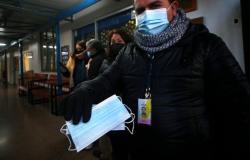Long Covidpost-covid, prolonged covid, chronic covid… These are the varied ways of calling a picture on which there is hardly any agreement on the name, because from there anyone has managed to describe exactly what symptoms or conditions already involves what percentage of people affects.
But what is being clearer every time is that The sequelae of SARS-COV-2 infection – the virus that in 2020 put in check the entire world– They impact different systems and organs. Also, on the brain: More precisely, about some structures of the central nervous system and biomarkers (for example, certain proteins) that are related to Alzheimer’s disease (EA) and other dementias.
A team of researchers led by The Argentine neuropsychiatrist Gabriel de Erausquin demonstrated in several works that The sequels of COVID-19 triple cognitive symptoms compatible with the early manifestations of Alzheimer’s disease in people from 60 to 70 years of no history Previous of such deterioration: loss of smell (persistent anosmia), short -term memory loss, difficulty in organization of daily tasks (executive function) and difficulty remembering words or names. These characteristics seem to be related to a certain genetic susceptibility, present both in the prolonged covid and in the EA.
“In the general population from 60 to 70 years the prevalence of EA early symptoms ranges between 6% and 8%. In the post-covid population we study the prevalence rate of these same symptoms was at least three times larger: between 21% and 30%. This means multiplying several times the risk of developing symptoms of cognitive impairment, ”explains The nation Gabriel de Erausquin, who has reside and works for several decades in the United States and is a distinguished professor of neurology and radiological sciences and director of the Laboratory for Development, Modulation and brain repair of the University of Texas, in San Antonio.
From Erausquin, 62, he remembers that when the pandemic began in 2020, he was at a meeting of the World Health Organization (WHO) in New Delhi, India, with a group of experts in neuropsychiatric evaluations. “Given the appearance of SARS-COV-2, the possibility of generating a longitudinally long-term longitudinal studies arose, combining results from different countries to study the neuropsychiatric sequelae of the infection,” We set out to build a consortium for that purpose, the Alzheimer’s association Consortium on the neurpsychiatric sequelae of Sars-Cov-2 (CNS Sars-COV-2), which continues to function and produce evidence”.
How did the experts already know at the beginning of the pandemic that the virus would cause cognitive impact? “It looked like the Middle East (Mers) respiratory syndrome and the severe acute respiratory syndrome (SARS), which had already had effects on the SNC – add the Argentine specialist -. At the beginning and peak of the pandemic, there were representatives of more than 30 countries in the consortium. Paquistan, Greece, Argentina, United States ”.
From Argentina, says Erausquin, post-covid patients are currently participating in several investigationsamong these, the one that studies the relationship between the variations of the complete genome of the SARS-COV-2 virus and the risk of cognitive impairment. In total there are 4300 patients from four US medical centers, one from Nigeria and another from the province of Jujuy.
“In Jujuy we are in the middle of recruitment, we have 2000 patients and we need to incorporate a thousand more,” says the neuropsychiatrist. Those interested can request personnel personally in Alvear 1152, San Salvador de Jujuy, from Monday to Friday from 13 to 19, or by phone at 388-4685535.
Together with the genetic variations, the most advanced age when contracting the virus, the persistent loss of smell-something that also happens in Parkinson and in frontotemporal dementia-and a reduction of certain brain structures (for example, the hippocampus) are the features that the researcher and his colleagues have identified as indicators of the highest cognitive risk after the infection by COVID-19. The cognitive sequelae, however, cannot be predicted according to the variants of the virus that has caused the infection or with the severity of the symptoms that have been presented.
From Erausquin, who is one of the four experts at the head of the International Network to Study Sars-Cov-2 Impact on Behavior and Cognition, he knows that there are several questions unanswered. “The first is that there is still no definition of post-covid. One of the collateral studies of the consortium that we form together with another European group is working to answer what the definition is and what the prevalence, because at this time there is no agreement on the subject,” he says.
However, the Argentine neuropsychiatrist explains that Two schools address the post-covid phenomenon from different points of view. “Between 5% and 10% they have physical symptoms. They are people who even years after infection get very fast, they have difficulty breathing or need oxygen, muscle weakness, the pressure is very quickly lowered or tachycardia. Memory or concentration, ‘Mental Fog’, but when the problem is evaluated, it cannot be objectified, it is a subjective sensation, ”he describes.
The other school focuses on cognitive symptoms. “In our samples we include patients from 58 years and older, –eusquin explains-in whom there is a loss of short-term memory, some difficulty in organization of tasks (executive function) and difficulty to remember words or names. These characteristics are not distinguished from early symptoms of Alzheimer’s disease and also seem to be related to certain genetic susceptibility, present both in the post-covid and EA.
The expert says that they still have no explanations about this association between EA early symptoms and cognitive sequelae in patients with prolonged COVID. “We handle three hypotheses. One, which are reversible symptoms, but this does not seem to be so because the populations we have been studying do not revert; Two, who are people who were going to have EA or other dementias anyway and that COVID-19 only anticipated the symptoms; Three, which COVID-19 produces a new, specific neurological picture of the virus. ”
While the hypothesis of a possible infectious origin for the EA has never been discarded (for example, it remembers ESUSQUIN, there is a correlation between this dementia and gingivitis), the Argentine researcher states that The conditions that the pandemic created allow a kind of natural experiment, with cohorts of thousands of people who had no history of dementia, in whom the only environmental factor is the SARS-COV-2 virus.
He adds that the cognitive symptoms found in about a third of post-covid patients are mild, that is, they suffer some degree of deterioration that affects a single domain, for example, executive function, memory, language. If the deficit is greater than a domain, which happens in about 10% of those studied, cognitive deterioration is already compatible with a dementia, which can be moderate or severe.
“The problem is that even with a mild cognitive impairment people have difficulty operating normally. Our investigations aim to determine in whom the risk is greater and shed light on how to intervene to reduce or prevent this deterioration. Covid has been one of those things that do not leave, such as a great war or a cataclysm, a giant earthquake. It did not affect everyone, but many. People recover, survive, but it is not the same after and entails consequences for a lifetime, ”says Erausquin.
“SARS-COV-2 is a synthetic virus – the Argentine specialist says. As soon as the pandemic has started, there was a publication of a Chinese group of Shanghai that already showed that the virus protein was semi -synthetic, that is, created in a laboratory. And that was confirmed that same year, through two groups that worked in one in Holland and one in the United Kingdom, which reached the same conclusion. The poor Chinese virologist who published it, Li Meng Yan, ended up living in California. ”
Erausquin points out that he does not believe it was a conspiracy. “I think the Chinese tried to develop a humanized virus to make a vaccine and escaped them, because the conditions of biosafety of the Wuhan laboratory were disastrous. Now it is known who financed it and who the researchers were: the story is told on the same White House website. What is not public knowledge is how this virus ended up circulating in the general population”, He concludes.
According to The criteria of





